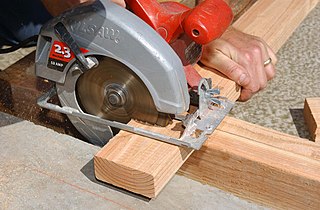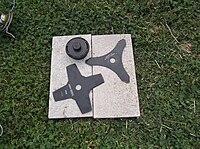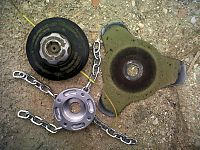
The router is a power tool with a flat base and a rotating blade extending past the base. The spindle may be driven by an electric motor or by a pneumatic motor. It routs an area in hard material, such as wood or plastic. Routers are used most often in woodworking, especially cabinetry. They may be handheld or affixed to router tables. Some woodworkers consider the router one of the most versatile power tools.

A circular saw is a power-saw using a toothed or abrasive disc or blade to cut different materials using a rotary motion spinning around an arbor. A hole saw and ring saw also use a rotary motion but are different from a circular saw. Circular saws may also be loosely used for the blade itself. Circular saws were invented in the late 18th century and were in common use in sawmills in the United States by the middle of the 19th century.

A drill is a tool used for making round holes or driving fasteners. It is fitted with a bit, either a drill or driver chuck. Hand-operated types are dramatically decreasing in popularity and cordless battery-powered ones proliferating due to increased efficiency and ease of use.

A chainsaw is a saw that cuts with a set of teeth attached to a rotating chain driven along a guide bar. Modern chainsaws are is used in activities such as tree felling, limbing, bucking, pruning, cutting firebreaks in wildland fire suppression, harvesting of firewood, for use in chainsaw art and chainsaw mills, for cutting concrete, and cutting ice. Precursors to modern chainsaws were first used in surgery, with patents for wood chainsaws beginning in the late 19th century.

Excavators are heavy construction equipment consisting of a boom, dipper, bucket and cab on a rotating platform known as the "house". The house sits atop an undercarriage with tracks or wheels. They are a natural progression from the steam shovels and often mistakenly called power shovels, as power shovels may have similar looking buckets. All movement and functions of a hydraulic excavator are accomplished through the use of hydraulic fluid, with hydraulic cylinders and hydraulic motors. Due to the linear actuation of hydraulic cylinders, their mode of operation is fundamentally different from cable-operated excavators which use winches and steel ropes to accomplish the movements.

A lawn mower is a device utilizing one or more revolving blades to cut a grass surface to an even height. The height of the cut grass may be fixed by the design of the mower but generally is adjustable by the operator, typically by a single master lever or by a mechanism on each of the machine's wheels. The blades may be powered by manual force, with wheels mechanically connected to the cutting blades so that the blades spin when the mower is pushed forward, or the machine may have a battery-powered or plug-in electric motor. The most common self-contained power source for lawn mowers is a small internal combustion engine. Smaller mowers often lack any form of self-propulsion, requiring human power to move over a surface; "walk-behind" mowers are self-propelled, requiring a human only to walk behind and guide them. Larger lawn mowers are usually either self-propelled "walk-behind" types or, more often, are "ride-on" mowers that the operator can sit on and control. A robotic lawn mower is designed to operate either entirely on its own or less commonly by an operator on a remote control.

A mower is a person or machine that cuts (mows) grass or other plants that grow on the ground. Usually mowing is distinguished from reaping, which uses similar implements, but is the traditional term for harvesting grain crops, e.g. with reapers and combines.

A string trimmer, also known by the portmanteau strimmer and the trademarks Weedwacker, Weed Eater and Whipper Snipper, is a garden tool for cutting grass, small weeds, and groundcover. It uses a whirling monofilament line instead of a blade, which protrudes from a rotating spindle at the end of a long shaft topped by a gasoline engine or electric motor.

An electric shaver is a razor with an electrically powered rotating or oscillating blade. The electric shaver usually does not require the use of shaving cream, soap, or water. The razor may be powered by a small DC motor, which is either powered by batteries or mains electricity. Many modern ones are powered using rechargeable batteries. Alternatively, an electro-mechanical oscillator driven by an AC-energized solenoid may be used. Some very early mechanical shavers had no electric motor and had to be powered by hand, for example by pulling a cord to drive a flywheel.
Gravely, of Brillion, Wisconsin, is a manufacturer of powered lawn and garden implements which it describes as "walk-behind, zero turn and outfront mowers". It started as a manufacturer of "walk-behind" or two-wheel tractors.
An edge trimmer or lawn edger is a garden tool, either manual or motorised, to form distinct boundaries between a lawn, typically consisting of a grass, or other soft botanical ground cover, and another ground surface feature such as a paved, concreted or asphalted area, or a granular material such as sand or gravel, or simply uncovered soil, for example an unbounded garden.

Flymo is a hover lawnmower invented by Karl Dahlman in 1964, after seeing Sir Christopher Cockerell's hovercraft. "Flymo" is a brand name of the Swedish company Husqvarna AB, a part of Electrolux from 1978 to 2006. The mower is a variation of the petrol-powered rotary push lawn mower, but uses a fan above the mower's spinning blades to allow the mower's body to hover over the lawn. The mower is claimed to be more manoeuverable and easier to push than wheeled petrol mowers, while delivering similar results.

A hedge trimmer, shrub trimmer, or bush trimmer is a gardening tool or machine used for trimming hedges or solitary shrubs (bushes). Different designs as well as manual and powered versions of hedge trimmers exist. Hedge trimmers vary between small hand-held devices to larger trimmers mounted on tractors.

A bush hog or "brush hog" is a type of rotary mower. Typically these mowers attach to the back of a farm tractor using the three-point hitch and are driven via the power take-off (PTO). It has blades that are not rigidly attached to the drive like a lawnmower blade, but are on hinges so if the blade hits a rock or stump, it bounces backward and inward, and then centrifugal force makes it go outwards again.

A flail mower is a type of powered garden/agricultural equipment which is used to deal with heavier grass/scrub which a normal lawn mower could not cope with. Some smaller models are self-powered, but many are PTO driven implements, which can attach to the three-point hitches found on the rear of most tractors. This type of mower is best used to provide a rough cut to long grass and even brambles in locations such as roadsides, where contact with loose debris may be possible.

The Allen Scythe, sometimes called the Allen Power Scythe, is a petrol-powered finger-bar mower. It was made from 1933 until 1973 by John Allen and Sons in Cowley, Oxfordshire. The company, formerly the Eddison and Nodding Company, was bought in 1897 by John Allen, who renamed it the Oxford Steam Plough Company, and then renamed it to John Allen and Sons.

A rotary mower is a unit of powered machinery that uses a rotating blade or blades to cut vegetation.
The saw chain, or cutting chain, is a key component of a chainsaw. It consists of steel links held together by rivets, and superficially resembles the bicycle-style roller chain, although it is closer in design to a leaf chain. Its key differences are sharp cutting teeth on the outside of the chain loop, and flat drive links on the inside, to retain the chain on the saw's bar and allow propulsion by the engine or motor.

Oregon Tool, Inc. is an American company that manufactures saw chain and other equipment for the forestry, agriculture, and construction industries. Based in Portland, Oregon, Oregon Tool globally manufactures their products in ten different plants across five countries. Oregon Tool produces and markets saw chain, chain saw bars and sprockets, battery operated lawn and garden equipment, lawn mower blades, string trimmer line, concrete cutting saws and chain, and agricultural cutting equipment for OEMs, dealers, and end-user markets. Oregon Tool employs approximately 3,300 people across the world in 17 global locations.
Emak is an Italian manufacturer and distributor of machines, components and accessories for gardening, agriculture, forestry and industrial applications. Emak's brands are: Efco, Oleo-Mac, Bertolini and Nibbi.



















